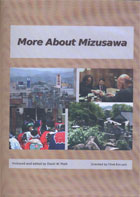
More about Mizusawa 2011
Distributed by Can't Go Native
Produced by David W. Plath
Directed by Chet Kincaid
DVD, color, 90 min.
Jr. High - General Adult
Asian Studies, Anthropology, History
Date Entered: 12/07/2011
Reviewed by Hong Cheng, Instruction/Reference Librarian, Indiana University Southeast, New Albany, INMizusawa is 250 miles away from the Northern part of Tokyo, Japan. More About Mizusawa provides an overview of this city’s rich history, culture, and religion based on Dr. Keith Brown’s extensive fieldwork. Through five dialogs with several anthropologists and historians, viewers will have a holistic view of this natural scenic yet modern city with wide-ranging sources.
The main character of the film, Dr. Brown, is the Professor of Anthropology and UCIS Research Professor Emeritus at the University of Pittsburgh. He has been researching Japanese kinship in Mizusawa since 1961. His solid friendship with the community in the past five decades enabled him to gain an insider’s perspective on many types of changes taking place throughout the local culture.
The first chapter of the film, Samurai Heritage, centers on the portrait of samurai in popular culture and the current living conditions of the samurais’ decedents. Enjoying higher social status, samurais were not the same as many people imagined. Most samurais never picked up a sword except to practice. People’s perception of them are also “admiration and contempt.” This chapter showcases samurai descendants’ altars and shrines in Mr.Obata’s house.
The second chapter covers the history of Mizusawa including a connection with the capital and with the outside world with the development of transportation. The chapter also briefly examines the development of different cultures in Japanese history like Jomon and Yayoi.
For viewers who are interested in learning the role of religion in Japan, the third chapter introduces how Buddhism shapes people’s daily life. The film also points out how religion in Japan requires actions more than faith.
The last two chapters talk about the personal life of Dr. Brown: what his life was like back in high school and how his family mingled with the Mizusawa community as the first foreign visitors.
With teaching guides downloadable via the project website cantgonative.com, the film would be helpful for world history classes for Grade 5-12. However, the first two chapters could be reordered and more historical knowledge should be introduced to reduce confusion since most Americans are not familiar with Japanese history. The mediocre cinematography, likely due to limited funding, may leave all but the most avid history buff unsatisfied.